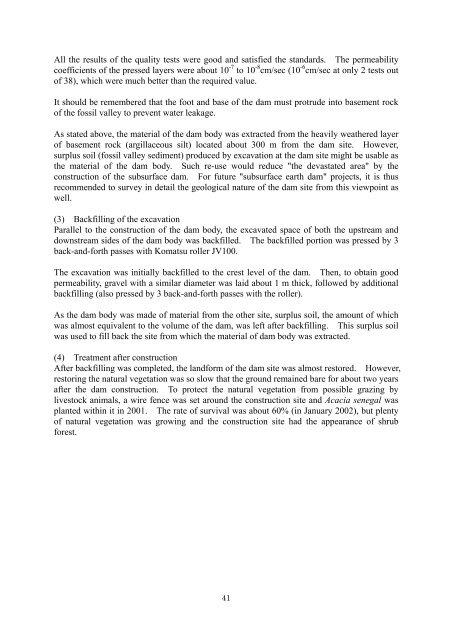SubSurface Dams - Sustainable Sanitation and Water Management ...
SubSurface Dams - Sustainable Sanitation and Water Management ...
SubSurface Dams - Sustainable Sanitation and Water Management ...
You also want an ePaper? Increase the reach of your titles
YUMPU automatically turns print PDFs into web optimized ePapers that Google loves.
All the results of the quality tests were good <strong>and</strong> satisfied the st<strong>and</strong>ards. The permeabilitycoefficients of the pressed layers were about 10 -7 to 10 -8 cm/sec (10 -6 cm/sec at only 2 tests outof 38), which were much better than the required value.It should be remembered that the foot <strong>and</strong> base of the dam must protrude into basement rockof the fossil valley to prevent water leakage.As stated above, the material of the dam body was extracted from the heavily weathered layerof basement rock (argillaceous silt) located about 300 m from the dam site. However,surplus soil (fossil valley sediment) produced by excavation at the dam site might be usable asthe material of the dam body. Such re-use would reduce "the devastated area" by theconstruction of the subsurface dam. For future "subsurface earth dam" projects, it is thusrecommended to survey in detail the geological nature of the dam site from this viewpoint aswell.(3) Backfilling of the excavationParallel to the construction of the dam body, the excavated space of both the upstream <strong>and</strong>downstream sides of the dam body was backfilled. The backfilled portion was pressed by 3back-<strong>and</strong>-forth passes with Komatsu roller JV100.The excavation was initially backfilled to the crest level of the dam. Then, to obtain goodpermeability, gravel with a similar diameter was laid about 1 m thick, followed by additionalbackfilling (also pressed by 3 back-<strong>and</strong>-forth passes with the roller).As the dam body was made of material from the other site, surplus soil, the amount of whichwas almost equivalent to the volume of the dam, was left after backfilling. This surplus soilwas used to fill back the site from which the material of dam body was extracted.(4) Treatment after constructionAfter backfilling was completed, the l<strong>and</strong>form of the dam site was almost restored. However,restoring the natural vegetation was so slow that the ground remained bare for about two yearsafter the dam construction. To protect the natural vegetation from possible grazing bylivestock animals, a wire fence was set around the construction site <strong>and</strong> Acacia senegal wasplanted within it in 2001. The rate of survival was about 60% (in January 2002), but plentyof natural vegetation was growing <strong>and</strong> the construction site had the appearance of shrubforest.41
















